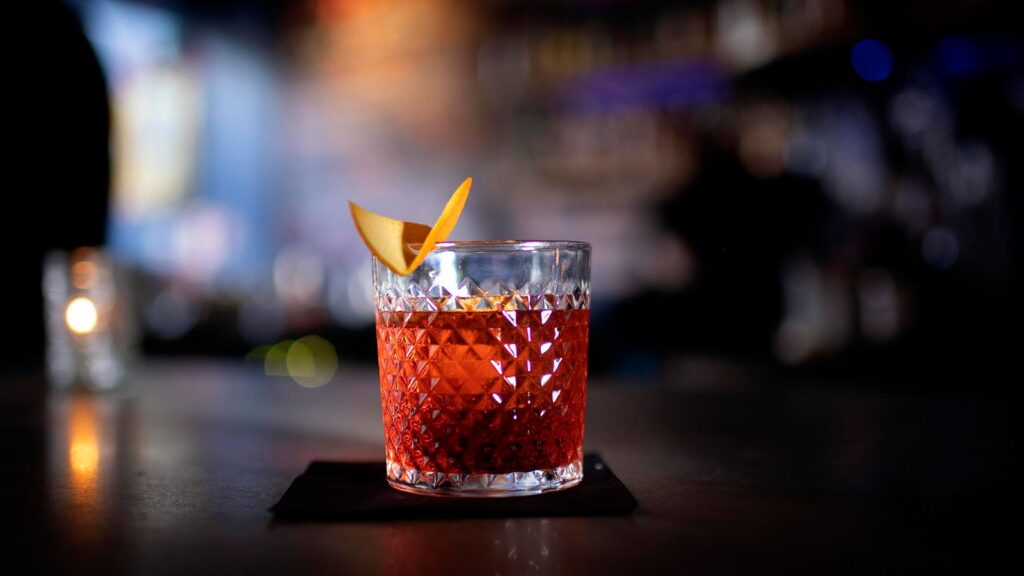The Negroni at Le Madeline. (Photo by Danielle Parhizkaran/The Boston Globe via Getty Images)
Boston Globe via Getty Images
Samantha Sheehan had been happily making wine in Napa Valley for more than 15 years, but it wasn’t until she sipped her first glass of Lillet that her life swiveled in a different direction.
“It just sort of opened my mind,” says Sheehan during a Zoom interview. She recalled her epiphany occurred while sipping the French aperitif at Angèle, a restaurant that sits along the Napa River. And immediately, she asked herself, “What would I do differently if I made an aperitif myself?”
Leaning on her expertise after years of making wines ranging from pinot noir to rosé, Sheehan took a barrel of her chardonnay wine and added Seville orange peels to make an aperitif that she initially called a vermouth. “I always just start from a flavor perspective of what I think tastes really good,” says Sheehan. “And then what comes second is what the consumer thinks and what they understand.”
That’s been a winning formula for her upstart California-based brand, Mommenpop, which sells three citrus aperitifs year-round and intends to add lime as a fourth offering in 2025. Earlier this year, Mommenpop got a boost on shelves by tapping into a relationship with wine and spirits distributor Southern Glazer’s, which opened 800 accounts in the state of California alone, including over 60 Whole Foods stores.
The Evolution Of The American Aperitif
While Americans have cultivated their own distinct approaches to making wine, beer and bourbon, Mommenpop is unique within an aperitifs, cordials and liqueurs category that remains dominated by the Europeans. Aperol, Campari, St-Germain, Grand Marnier and Jägermeister are all commonly found in American bars and restaurants, and they all come from Europe.
California-based brand Mommenpop sells three citrus aperitifs year-round and intends to add lime as … [+] a fourth offering in 2025.
Courtesy of Nicola Parisi
But Americans like Sheehan are making inroads for a category that generates nearly $3 billion in revenue for distillers in the U.S. market annually, according to data from industry advocate the Distilled Spirits Council of the United States (DISCUS). And much of the growth for cordials and liqueurs is coming from the higher-end price points, DISCUS reports, which is what the American aperitif offerings tend to gravitate to, mostly due to the more premium priced ingredients that are used.
It hasn’t always been a smooth, upward march for the Americans. Sonoma-founded Haus, an aperitif brand that generated some of the biggest press buzz stateside for the category in recent years, shut down production in 2022 due to funding challenges with investors. The brand has been gingerly pursuing a comeback since the financing setback, selling itself last year to beverages startup The Naked Market.
Eric Bachli spent years developing dozens of beer brands but leaned on his Swiss heritage when he pivoted to craft a New York-based lemon liqueur brand called Le Moné. “That kind of apéritif culture largely influenced the way I drink,” recalls Bachli of how he was raised in a family that enjoyed European liqueurs that weren’t as prevalent in the U.S. at the time.
How To Make An Aperitif Americans Will Actually Drink
As an adult, he would visit Switzerland and other European countries and saw the dominance of the Aperol spritz and Hugo spritz, both of which made inroads at American bars and hotels in recent years. He wanted to develop his own version of an aperitif, but with less sugar and bitterness than what was available.
“We wanted to bring one of the most popular citrus elements, lemon, into the aperitif,” says Bachli.
Eric Bachli spent years developing dozens of beer brands, but leaned on his Swiss heritage when he … [+] created the New York-based lemon liqueur brand Le Moné.
Courtesy of Le Moné
The biggest struggle he’s faced as the brand expands beyond New York to other markets like New Jersey, Massachusetts and Florida is that Americans still don’t fully understand what an aperitif is. Aperitifs are typically served before a meal, a lower-alcohol drink that’s meant to stimulate the appetite. That’s not a drinking occasion that’s ever taken root in American culture, experts say.
One tactic that Le Moné has employed to spread the word is tasting activations to get “liquid to lips,” says Bachli. American producers should aim to differentiate themselves from the Europeans, not try to replicate what’s already been done.
Sheehan says that’s similar to her approach as a winemaker. While she personally loves wines from France’s Burgundy and Spanish Rioja, there’s no need for an exact replica from the U.S.
“I always made my wines with a nod to the old world,” says Sheehan. “I didn’t want to recreate what they’re doing in France or Italy [with Mommenpop]. I wanted to have a California version.”
Source link : http://www.bing.com/news/apiclick.aspx?ref=FexRss&aid=&tid=6719370a9c8f4e3a8e4ed6cdf7853676&url=https%3A%2F%2Fwww.forbes.com%2Fsites%2Fjohnkell%2F2024%2F10%2F23%2Fhow-americans-are-bringing-a-new-twist-to-the-european-aperitif%2F&c=1489629887551417138&mkt=de-de
Author :
Publish date : 2024-10-23 10:47:00
Copyright for syndicated content belongs to the linked Source.
